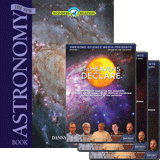
Review of National Geographic’s Origins: Shelter, Exploration, and Transportation
Episodes 6–8 of Origins: The Journey of Humankind
Episode 6–“Building the Future”
Jason Silva opens this episode of Origins with a brief assessment of humanity. “Shelter is the story of how we shaped the world around us, and how that world has shaped us back. Shelter brought us together, but it also separates and divides us. We are one species with billions of individuals.”
Ancient Man Was Intelligent and Resourceful
We are hurled back in time to Ice Age Eurasia in 12,000 BC (which we would state is around 2,000 BC), where a man who has been attacked by lions makes it back to his tribe but dies shortly thereafter. The tribe has a funeral ritual and buries him. But the tribe lives in mammoth bone huts and has protection against predators when they shelter together.
We then jump to AD 600–1300 to Pueblo, Colorado, and see the intricate earthworks and walls the Pueblos built in the cliffs and caves they lived in. Next we’re transported back to 9,000 BC (by our estimations, closer to 1900–1800 BC) to Göbekli Tepe in Turkey. There we see intricate carvings and the remains of elaborate and sophisticated structures. We also see raised stone pillars, which weighed as much as 16 tons. While National Geographic may have some of the dates wrong, they at least acknowledge that ancient man was intelligent, creative, and artistic.
Let in the Light
From there we move forward to AD 79 and the city of Pompeii. Roman glass was just beginning to be commercially made and used in windows. This allowed natural light to come into the house but kept out dust, bugs, and rain. Most history buffs will recognize the above date as the time when Mt. Vesuvius erupted and destroyed Pompeii and Herculaneum. Archaeologists discovered pieces of these glass window panes in the preserved ruins of the city.
From there we’re taken on a brief excursion through different types of windows, including ornate stained glass windows. Finally we end up with a quick glimpse of the electric light bulb. This was an invention that revolutionized not just the home but architecture as a whole as well as industry. As the show points out, up until the invention of the electric light, most homes at night had less light than what emanates from our refrigerator when we open it. Before electric light, everyone gathered around a small lamp or single candle as they finished chores for the night before going to bed.
Urban Heights to Suburban Sprawl
But houses and businesses had other limitations besides lighting. Most buildings in the 19th century were 7 stories or fewer. People did not want to climb more stories than this. So apartment buildings and businesses were shorter with a broad footprint. However the invention of the safety brake for elevators in 1853 started to change this. After the first passenger elevator was invented in 1857, it wasn’t long before buildings started to grow in height. This reduced the need for buildings to have a large footprint, so companies and apartment buildings began building upward. Because of passenger elevators, the ground floors were no longer the most coveted, since people wanted to have the scenic views from the higher floors. Coupled with the technological developments of the day, the job market in cities increased as well. This led to overcrowding in the cities and the need for residential areas to move to the suburbs. The first such planned suburban community was established in Levittown, New York.
Episode 7–“Into the Unknown”
Of the three, this episode definitely dealt the most with evolution. However, at least ancient man is viewed as resourceful and brave. We start out in supposedly 50,000 BC Indonesia (and again, we would claim that this is a post-Babel, Ice Age timeframe of c. 2000 BC), where a people group has migrated and are at war over resources with their neighbors. They are deciding whether to leave on a voyage across the open ocean or stay and fight.
A scouting party comes back, claiming that, though they had not seen land, they had seen flocks of birds. They take this as a sign that there is land out there. So the tribe decides to take their chances and set out. After several days they land in what is now Australia. But there are several problems with this portrayal (aside from the timeline). Why set out across the open ocean? You can island-hop from Indonesia to Australia even today, with only 40 miles between each island. And during the Ice Age with lower sea levels, this would have been much less. And why not settle down on an island before setting off again? The portrayed tribe consisted of fewer than 20 people. Do they really need that much space and that many resources?
From Australia, we go on a brief journey to space, highlighting some of the inventions that make life possible and comfortable in space. Then we go back in time to the Viking era of AD 750–1050 to look at how they used their mastery of the longboat to conquer and set up trade routes all over Europe and Asia, and to reach the New World.
Mythology and Mockery
National Geographic couldn’t help but get involved in landing a few subtle jabs at Scripture. Host Jason Silva goes on an extended monologue about epic mythology, with Genesis 6–8 squarely in his sights.
One story has lasted for thousands of years. A recurring myth adopted by cultures around the globe—the hero’s journey. It’s a story of courage and bravery, an adventure to the end of the known world. The hero changes, but the story remains the same. It was first carved into clay about 4,000 years ago—the Epic of Gilgamesh. The ancient story of a god-king who journeyed to the edge of the world and back. In Greece the hero was reborn as Odysseus, and the hero’s journey became memorialized yet again. This eternal myth lives on even today, inspiring the most legendary films [a Star Wars: A New Hope movie poster is shown].
These tales of bravery have empowered generations of explorers and adventurers, steering us to unfamiliar places. Revealing new truths about the world and even about ourselves. [Here there are clear images of famous paintings depicting Noah’s Flood, and finally a Bible is shown with its pages turning in the breeze].
So it is quite clear that the folks at National Geographic believe the Gilgamesh Epic was the basis for the Genesis account of the Flood, which is portrayed as myth and epic storytelling. But why would a Middle Eastern “myth” be remembered and “adopted” by cultures around the world? And why would the biblical account be written as a straightforward historical account stripped of the epic storytelling, fantastical elements, and fanatical gods found in most of the other Flood legends? It is far more logical to see the Genesis Flood as the true account, manifested in a dim cultural memory for all peoples, distorted and embellished since the dispersion at Babel.
Compasses, Sonar, and Telescopes (With a Side of Revisionism)
We move forward in time to 206 BC Han Dynasty China where lodestone is used to make a Heaven’s Plate, a fortune-telling device that 1,000 years later would be refashioned into the first compass. This allowed the Chinese to set about upon a brief period of naval discovery before internal wars caused them to become more isolationist.
Then we arrive in 1952 where sonar (developed during WWII) allowed us to map the ocean floor. Marie Tharp charted the ocean floor from military sonar maps and discovered the Mid-Atlantic Ridge.
Then we are transported back in time to 1609 in Padua, Italy, where Galileo refined his telescope and discovered that Jupiter had moons, which were orbiting the planet. This led him to reject geocentrism and, in time, accept the heliocentric model of the solar system, developed by Nicolaus Copernicus in 1543.
Then we are shown Galileo’s heresy trial of 1633, which has often (and is here) portrayed as a battle of science versus religion when in fact it was a battle of the accepted Aristotelian science versus good observational science.
Goldilocks Planets and Salt Mines
At the end of the episode, we get to the “enlightened” part. Now that National Geographic has shown us that the Genesis Flood is a myth, and that backward religionists have persecuted science since the days of Galileo, we get a glimmer of hope for the future. Now that we’ve discovered so many exoplanets (with trillions more out there to be discovered), we can begin to wonder about life on other worlds.
In fact, that’s why we end up in the Boulby Salt Mine in Saltburn, England. Because Mars has salt domes on it, and life is thought to be best found underground on Mars, what better way to look for the conditions for Martian life than by looking for salt-tolerant microbes underground on earth?
In case you didn’t see the irony here, it is that the real epic storytelling and mythology on this show is the “life on other planets” tale we constantly hear, along with the tired old canard of “science versus religion” at Galileo’s trial.
Episode 8– “The Road Ahead”
This final (at least for now) episode is quite possibly the least evolutionary one of the eight. Other than a brief mention that horses were first domesticated in Kazakhstan “around 5,000 years ago” (we would knock at least 1,000 years off that number), there really are no evolutionary agendas or statements in this program.
The Importance of the Horse
We start off in AD 61 Britain, where the Romans are trying to keep down a revolt by the Celts and maintain control over the area. Getting messages to far-away garrisons at the edge of the Roman Empire is not an easy task, and the rough countryside was causing horses to come up lame and jeopardizing the ability to get messages through to other command posts.
In a reenactment, we see a pair of Roman legionnaires riding off. When one horse starts to have difficulty, the rider dismounts, gives his message to the other rider, and lays low. He eventually comes upon a Celtic blacksmith and asks him to make a metal horseshoe. It seems that the Romans had developed the concept of a strapped-on horseshoe (called a hipposandal) in about 80 BC, although this program seems to imply that the Celts improved upon the Roman design. But eventually the shoes are made, and the Romans begin to mass-produce them for their horses and mules. This helps them in the building of their empire. A quick montage then shows the importance of the horse for many things, such as farming, hauling supplies, and warfare. The Romans even developed a kind of pony express for delivering letters to parts of the empire.
The Iron Horse and the Bicycle
From Roman Britain we jump forward in time to present-day Britain to learn a little about the history of the railroad. The first steam engine rail locomotive was built in 1811 and passenger trains followed in just another two decades. Railroads, the next leap in transportation from the horse, opened up a whole new area of transporting freight, goods, and passengers. Towns started springing up around railroad hubs in Britain and the United States. Today, high speed trains are seeing a resurgence in popularity in Europe and Asia.
Next we’re shown how the bicycle in the late 19th and early 20th century revolutionized personal freedom and fashion for women. The bicycle allowed women to be more independent and led to the change in fashion from hoop skirts to pants. And the bicycle was also what the Wright Brothers started building; in fact, they applied many of the principles from their bike shop to their airplane designs.
Cars, Highways, and Drones
Of course, no show on transportation could overlook what have been the most heavily used and influential inventions (at least from the late 19th century onward)—the internal combustion engine and the automobile. Back in 1919, the Army decided to run a test. They sent out a group of soldiers in cars to see how long it would take to get from Washington, DC, to San Francisco and to evaluate the quality of the roads and infrastructure. The test failed miserably, seeing that roads were terrible (or nonexistent) and repair shops and gas stations were few and far between.
One of the men involved in this test was (at the time) Lt. Col. Dwight D. Eisenhower. Later, when he served as a general in WWII and saw the efficiency of the Autobahn in Germany, he decided that he would like to see that type of highway system implemented in the United States. When he became US president, he made the road system a priority of his administration. The Interstate Highway System project was started in 1956 under his presidency. Eisenhower wanted the interstate system to be robust and sturdy enough to handle military traffic (transportation of missiles and tanks) if needed. But the opening of the interstates also transformed businesses with trucking becoming just as important for freight shipping as rail.
In 1939 actor Reginald Denny showed his large RP4 radio-controlled airplane to the military. At first they were not interested, but with the United States’ entry into WWII in 1941, the prospect of such planes for spying and reconnaissance missions was much more attractive. The Northrop Corporation bought out Denny and began producing their drone planes in 1942. The episode briefly highlighted the future of drones in combat missions and as package carriers. The end of the show looked ahead to driverless cars, virtual vacations, and other transportation possibilities of the future (or virtual transportation possibilities).
Again, no evolutionary baggage in this episode, just good technology brought on by experimental science—science that can be performed and repeated with expected results, because we live in an orderly universe created and sustained by an orderly God (Colossians 1:16–17).
The series as a whole was a mixed bag. Some brilliant observations, some neat historical insights, but also some flights of fancy disguised as science. The series revealed a love/hate relationship with Christianity, acknowledging some of the positives (like increased literacy from the printing of the Bible in native languages) and inventing some of the negatives (like the supposed religion vs. science fight).
Recommended Resources

Answers in Genesis is an apologetics ministry, dedicated to helping Christians defend their faith and proclaim the good news of Jesus Christ.
- Customer Service 800.778.3390
- © 2024 Answers in Genesis






